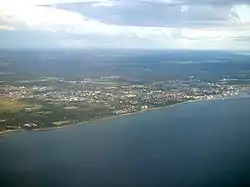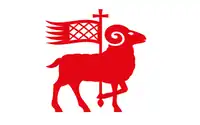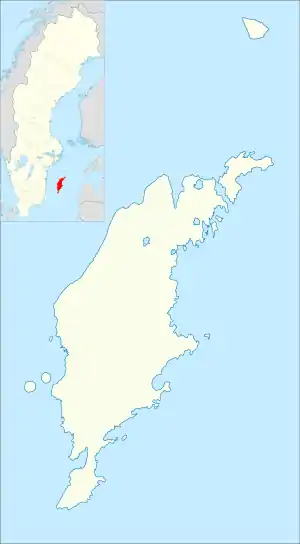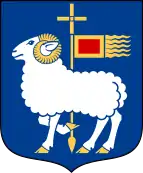Region Gotland
| |
|---|---|
 | |
 Flag | |
 Region Gotland | |
| Coordinates: 57°38′N 18°17′E / 57.633°N 18.283°E | |
| Country | |
| National Area | Småland and the islands |
| County | Gotland County |
| Seat | Visby |
| Area | |
| • Total | 15,241.07 km2 (5,884.61 sq mi) |
| • Land | 3,134.05 km2 (1,210.06 sq mi) |
| • Water | 12,107.02 km2 (4,674.55 sq mi) |
| Area as of 1 January 2014. | |
| Population (31 December 2021)[2] | |
| • Total | 61,001 |
| • Density | 18.9/km2 (49/sq mi) |
| Time zone | UTC+1 (CET) |
| • Summer (DST) | UTC+2 (CEST) |
| ISO 3166 code | SE |
| Province | Gotland |
| Municipal code | 0980 |
| Website | www.gotland.se |
Region Gotland, officially Gotlands kommun (English: Gotland Municipality), is a municipality that covers the entire island of Gotland in Sweden. The city of Visby is the municipality's seat. Gotland Municipality is the 39th most populous municipality in Sweden.[3]
The flag of the municipality is a red ram on a white background.[4]
History
On 31 December 1951 there were 93 local government units on the island of Gotland, among them one city (Visby), one market town (Slite), one county council and a lot of rural municipalities, many of them with fewer than 100 inhabitants.
Twenty years later the situation was totally different.
The first of the two nationwide local government reforms in Sweden during the 20th century was implemented on 1 January 1952. From that date on, the rural municipalities on the island were regrouped into twelve new enlarged municipalities, which together with Visby, Slite and the Gotland County Council formed the new administrative pattern.
After ten years it was clear that this reform had not been radical enough and the work began preparing for the next one.
On 1 January 1971 the second and last local government reform was implemented in Sweden. All administrative and judicial differences between rural and urban areas were abolished. Only one type of municipality (kommun) existed from that date on. In the case of Gotland all the former entities were united into one single unit. As there was only one municipality in the county, also the County Council was abolished and merged into the new unitary municipality.
As the municipality has both local and regional functions, normally provided by the Municipalities of Sweden and the County councils of Sweden respectively, Gotland has a special status as a municipality and is officially called Region Gotland as of 2011.
Localities
There are 16 urban areas (also called a Tätort or locality) in Gotland Municipality.
In the table the localities are listed according to the size of the population. The municipal seat is in bold characters.
| # | Locality | Population in 2005 | Population in 2012[5] |
|---|---|---|---|
| 1 | Visby | 22,236 | 23,576 |
| 2 | Hemse | 1,836 | 1,734 |
| 3 | Slite | 1,598 | 1,500 |
| 4 | Klintehamn | 1,407 | 1,350 |
| 5 | Vibble | 1,135 | 1,300 |
| 6 | Romakloster | 905 | 949 |
| 7 | Fårösund | 862 | 800 |
| 8 | Lärbro | 521 | 500 |
| 9 | Burgsvik | 347 | 350 |
| 10 | Stånga | 342 | 300 |
| 11 | Havdhem | 318 | 300 |
| 12 | Västerhejde | 302 | n a[6] |
| 13 | Tingstäde | 278 | n a[6] |
| 14 | Väskinde | 275 | 250 |
| 15 | Roma kyrkby | 253 | n a[6] |
| 16 | När | 209 | n a[6] |
Politics
Riksdag
These are the results of the elections to the Riksdag held in Gotland since 1973. The results only include parties that have won representation in the Riksdag assembly at least once during this timeframe. The results of the Sweden Democrats were not listed at a municipal level by the SCB between 1988 and 1998 due to the party's small size at the time.
| Year | Turnout | Votes | V | S | MP | C | L | KD | M | SD | ND |
|---|---|---|---|---|---|---|---|---|---|---|---|
| 1973[7] | 90.2 | 34,168 | 1.8 | 37.2 | 0.0 | 39.6 | 7.3 | 1.0 | 12.7 | 0.0 | 0.0 |
| 1976[8] | 90.7 | 36,105 | 2.6 | 37.7 | 0.0 | 37.3 | 8.3 | 0.6 | 13.4 | 0.0 | 0.0 |
| 1979[9] | 90.0 | 36,585 | 4.2 | 38.7 | 0.0 | 31.3 | 8.7 | 0.6 | 16.1 | 0.0 | 0.0 |
| 1982[10] | 90.6 | 37,646 | 3.7 | 42.1 | 2.3 | 27.3 | 5.1 | 1.0 | 18.3 | 0.0 | 0.0 |
| 1985[11] | 88.9 | 37,766 | 3.7 | 41.8 | 2.5 | 24.4 | 10.4 | 0.0 | 17.0 | 0.0 | 0.0 |
| 1988[12] | 85.8 | 36,362 | 4.1 | 41.0 | 6.8 | 25.0 | 7.9 | 1.5 | 13.4 | 0.0 | 0.0 |
| 1991[13] | 85.9 | 36,458 | 3.8 | 36.2 | 4.3 | 20.7 | 6.6 | 5.0 | 16.7 | 0.0 | 6.4 |
| 1994[14] | 86.1 | 37,009 | 5.2 | 43.5 | 6.7 | 17.9 | 4.5 | 2.5 | 18.0 | 0.0 | 1.3 |
| 1998[15] | 79.8 | 34,201 | 10.8 | 34.8 | 5.7 | 15.0 | 3.4 | 8.7 | 19.2 | 0.0 | 0.0 |
| 2002[16] | 79.0 | 34,376 | 8.4 | 40.8 | 5.5 | 15.6 | 7.8 | 6.5 | 14.0 | 0.6 | 0.0 |
| 2006[17] | 81.4 | 35,750 | 6.0 | 34.9 | 6.3 | 19.3 | 4.4 | 3.8 | 21.6 | 1.6 | 0.0 |
| 2010[18] | 84,9 | 38,640 | 6.1 | 33.3 | 8.4 | 14.6 | 4.6 | 2.9 | 25.2 | 3.2 | 0.0 |
| 2014[19] | 86.5 | 39,655 | 5.8 | 32.2 | 7.2 | 13.4 | 3.8 | 2.8 | 21.3 | 8.2 | 0.0 |
| 2018[20] | 88.8 | 41,129 | 9.0 | 29.8 | 5.0 | 17.2 | 3.7 | 4.1 | 16.6 | 12.7 | 0.0 |
Blocs
This lists the relative strength of the socialist and centre-right blocs since 1973, but parties not elected to the Riksdag are inserted as "other", including the Sweden Democrats results from 1988 to 2006, but also the Christian Democrats pre-1991 and the Greens in 1982, 1985 and 1991. The sources are identical to the table above. The coalition or government mandate marked in bold formed the government after the election. New Democracy got elected in 1991 but are still listed as "other" due to the short lifespan of the party. "Elected" is the total number of percentage points from the municipality that went to parties who were elected to the Riksdag.
| Year | Turnout | Votes | Left | Right | SD | Other | Elected |
|---|---|---|---|---|---|---|---|
| 1973 | 90.2 | 34,168 | 39.0 | 59.6 | 0.0 | 1.4 | 98.6 |
| 1976 | 90.7 | 36,105 | 40.3 | 59.0 | 0.0 | 0.7 | 99.3 |
| 1979 | 90.0 | 36,585 | 42.9 | 56.1 | 0.0 | 1.0 | 99.0 |
| 1982 | 90.6 | 37,646 | 45.8 | 50.7 | 0.0 | 3.5 | 96.5 |
| 1985 | 88.9 | 37,766 | 45.5 | 51.8 | 0.0 | 2.7 | 97.3 |
| 1988 | 85.8 | 36,362 | 51.9 | 46.3 | 0.0 | 1.7 | 98.3 |
| 1991 | 85.9 | 36,458 | 40.0 | 49.0 | 0.0 | 11.0 | 95.6 |
| 1994 | 86.1 | 37,009 | 55.4 | 40.4 | 0.0 | 4.2 | 95.8 |
| 1998 | 79.8 | 34,201 | 51.3 | 46.3 | 0.0 | 2.4 | 97.6 |
| 2002 | 79.0 | 34,376 | 54.7 | 43.9 | 0.0 | 1.4 | 98.6 |
| 2006 | 81.4 | 35,750 | 47.2 | 49.1 | 0.0 | 3.7 | 96.3 |
| 2010 | 84,9 | 38,640 | 47.8 | 47.3 | 3.2 | 1.7 | 98.3 |
| 2014 | 86.5 | 39,655 | 45.2 | 41.3 | 8.2 | 5.3 | 94.7 |
| 2018 | 88.8 | 41,129 | 43.8 | 41.6 | 12.7 | 1.9 | 98.1 |
Local
Election results:
| Party | Seats in the 2002 election | Seats in the 2006 election | Seats in the 2010 election | Seats in the 2014 election |
Seats in the
2018 election[21] | |
|---|---|---|---|---|---|---|
| Swedish Social Democratic Party | 28 | 24 | 24 | 21 | 18 | |
| Centre Party | 13 | 17 | 15 | 14 | 18 | |
| Moderate Party | 11 | 14 | 15 | 13 | 11 | |
| Left Party | 8 | 7 | 6 | 7 | 7 | |
| Liberal People's Party | 4 | 4 | 4 | 4 | 3 | |
| Green Party | 4 | 4 | 7 | 8 | 4 | |
| Christian Democrats | 3 | 1 | 0 | 0 | 2 | |
| Sweden Democrats | 0 | 0 | 0 | 3 | 6 | |
| Feminist Initiative | 0 | 0 | 0 | 1 | 2 | |
| Total | 71 | 71 | 71 | 71 | 71 | |
Region
When Gotland was made into a single municipality in the 1970s, the county council was abolished and its responsibilities transferred to the municipality, making it a unitary authority. During a trial period some of the authority normally held by the Gotland County Administrative Board, an agency of the national government, has also been devolved to the Gotland Municipality, as well as to two mainland councils. The municipality of Gotland is therefore in this respect also a region. It has responsibility for the public healthcare system and public transport.
Events organised by the municipality
The municipality coordinates the annual Almedalen Week (Almedalsveckan), an important meetingplace for everyone involved in Swedish politics. During the week, representatives from the political parties in the Riksdag take turns to hold speeches in the Almedalen park in Visby.
See also
References
- ↑ "Statistiska centralbyrån, Kommunarealer den 1 januari 2014" (in Swedish). Statistics Sweden. 1 January 2014. Archived from the original (Microsoft Excel) on 27 September 2016. Retrieved 18 April 2014.
- ↑ "Folkmängd i riket, län och kommuner 31 december 2021" (in Swedish). Statistics Sweden. 22 February 2022. Retrieved 22 February 2022.
- ↑ "Folkmängd, topp 50". Statistiska Centralbyrån (in Swedish). Retrieved 12 June 2022.
- ↑ "Om Region Gotlands flagga" [About Region Gotland's flag]. Region Gotland (in Swedish). 1 December 2022. Retrieved 4 May 2023.
- ↑ "Gotland i siffror, pdf". www.gotland.se (in Swedish). Region Gotland. pp. 65–67. Retrieved 13 June 2014.
- 1 2 3 4 Some numbers are not available for 2012, since the population was listed as inhabitants in each socken. Only a few localities were mentioned, and these only as approximations.
- ↑ "Riksdagsvalet 1973 (page 163)" (PDF) (in Swedish). SCB. Retrieved 6 August 2017.
- ↑ "Riksdagsvalet 1976 (page 158)" (PDF) (in Swedish). SCB. Retrieved 6 August 2017.
- ↑ "Riksdagsvalet 1979 (page 182)" (PDF) (in Swedish). SCB. Retrieved 6 August 2017.
- ↑ "Riksdagsvalet 1982 (page 183)" (PDF) (in Swedish). SCB. Retrieved 6 August 2017.
- ↑ "Riksdagsvalet 1985 (page 184)" (PDF) (in Swedish). SCB. Retrieved 6 August 2017.
- ↑ "Riksdagsvalet 1988 (page 165)" (PDF) (in Swedish). SCB. Retrieved 6 August 2017.
- ↑ "Riksdagsvalet 1991 (page 25)" (PDF) (in Swedish). SCB. Retrieved 6 August 2017.
- ↑ "Riksdagsvalet 1994 (page 39)" (PDF) (in Swedish). SCB. Retrieved 6 August 2017.
- ↑ "Riksdagsvalet 1998 (page 35)" (PDF) (in Swedish). SCB. Retrieved 6 August 2017.
- ↑ "Valresultat Riksdag Gotlands kommun 2002" (in Swedish). Valmyndigheten. Retrieved 6 August 2017.
- ↑ "Valresultat Riksdag Gotlands län 2006" (in Swedish). Valmyndigheten. Retrieved 6 August 2017.
- ↑ "Valresultat Riksdag Gotlands län 2010" (in Swedish). Valmyndigheten. Retrieved 6 August 2017.
- ↑ "Valresultat Riksdag Gotlands län 2014" (in Swedish). Valmyndigheten. Retrieved 6 August 2017.
- ↑ "Gotlands län - Röster - Val 2018". data.val.se. Retrieved 7 June 2021.
- ↑ "Gotland - Valda - Val 2018". data.val.se. Retrieved 7 June 2021.
External links
- Gotland Municipality – Official site
- Coat of arms
